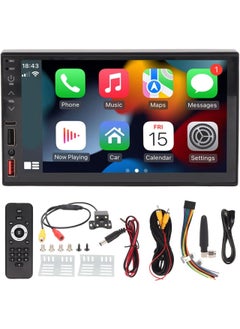Highlights- The stereo typically has a power button to turn it on and off.
- It allows you to choose the audio source, such as radio, CD, USB, Bluetooth, or auxiliary input.
- This feature enables you to listen to AM/FM radio stations. It usually includes options to manually tune stations or save presets.
- Modern car stereos support various media playback options, including CDs, USB drives, and sometimes DVDs. MP3, WMA, and other audio file formats are commonly supported.
- Many car stereos come with Bluetooth functionality, allowing you to wirelessly connect your smartphone or other Bluetooth-enabled devices for hands-free calling and audio streaming.
- This feature allows you to connect external audio devices, such as smartphones, MP3 players, or laptops, via a standard audio cable.
- The stereo often includes a USB port for connecting USB drives or smartphones for media playback and charging.
- Car stereos typically offer various sound settings and equalizer presets to customize the audio output according to your preferences.Some advanced car stereos feature a touchscreen display for easier navigation and control of features and settings.
OverviewINSTALLATION: The car stereo is installed in the dashboard of the vehicle. Installation may involve removing the existing stereo unit, connecting wiring harnesses, and mounting the new stereo securely in place.
POWER ON: When the ignition is turned on or the car stereo is manually powered on, the display screen lights up, indicating that the stereo is ready for use.
SOURCE SELECTION: Users can choose from various audio sources such as radio, CD/DVD player, USB drive, Bluetooth, auxiliary input, or sometimes even digital media streaming services if the stereo is equipped with internet connectivity.
RADIO TUNING: If the user selects the radio as the source, they can tune to their desired AM or FM radio station using the stereo's tuner controls. Some models offer automatic station scanning and preset memory for quick access to favorite stations.
MEDIA PLAYBACK: For CD/DVD playback, users can insert discs into the appropriate slot, and the stereo will read and play the content. Alternatively, they can plug in a USB drive containing audio files or connect a Bluetooth-enabled device for wireless media streaming.
BLUETOOTH CONNECTIVITY: If the car stereo supports Bluetooth, users can pair their smartphones or other compatible devices to wirelessly stream music, make hands-free calls, and access other audio content.
AUXILIARY INPUT: An auxiliary input allows users to connect external audio devices such as MP3 players, smartphones, or portable music players using a compatible cable.
DISPLAY AND CONTROLS: The car stereo typically features a display screen where users can view track information, radio station frequencies, and menu options. It also includes physical controls such as buttons, knobs, and touchscreen interfaces for navigating menus, adjusting volume, and controlling playback.
SOUND SETTINGS: Users can customize the audio output using built-in equalizer settings, balance, fader controls, and other sound enhancement features to suit their preferences and optimize the listening experience.
NAVIGATION (OPTIONAL): Some car stereos come equipped with GPS navigation systems, providing turn-by-turn directions, real-time traffic updates, and points of interest. Users can input destinations and view maps directly on the stereo's display screen.
VOICE CONTROL (OPTIONAL): Advanced car stereo models may offer voice control functionality, allowing users to operate certain features and make hands-free calls using voice commands.
SAFETY FEATURES: To promote safe driving, car stereos often include features such as automatic volume adjustment based on vehicle speed, integration with steering wheel controls, and compatibility with backup cameras for improved visibility while reversing.
Free & Easy Returns
Best Deals





